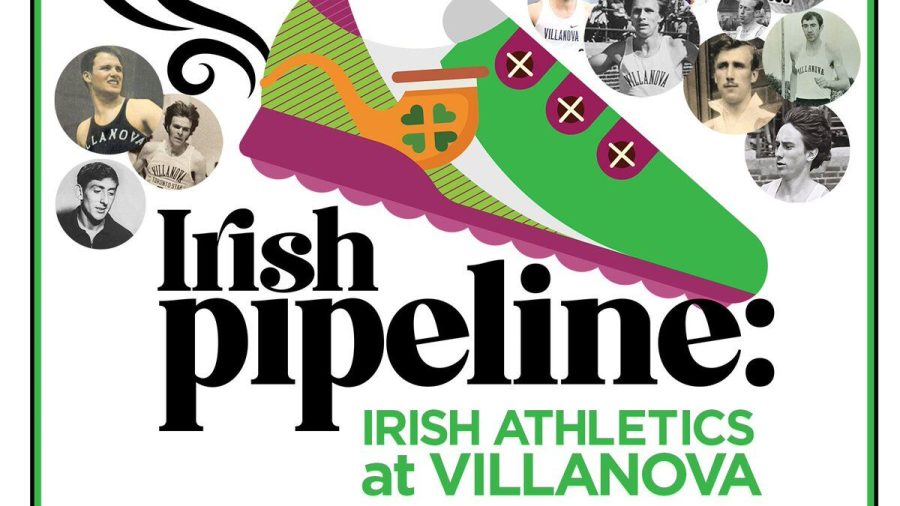Falvey Library Hosts Lecture About the Irish Pipeline
Courtesy of Falvey Memorial Library
The Irish Pipeline refers to Olympians from Ireland.
March 10, 2021
On Thursday, March 4, a Zoom informational seminar about the Irish Pipeline was held by Falvey Memorial Library. Marcus O’Sullivan ‘84 and Beaudry Rae Allen ‘13 were the two guest speakers who shared their knowledge about the Irish Pipeline and the role it played at the University.
O’Sullivan is a four-time Olympic miler and is currently the head coach of the track and field team at the University, and he has been the men’s distance coach since 2000. O’Sullivan is originally from County Cork, Ireland and began his successful running career at the University at the age of 19. He has won 10 Big East titles and is one of three people to run more than 100 sub-four minute miles.
Allen is originally from California and graduated from the University in 2013. She is currently working at Villanova as a preservation and digital archivist at Falvey Memorial Library and has had first hand experience with the history of the Irish Pipeline at the University.
The Irish Pipeline began in 1948 when Jimmy Reardon became the first Irish runner and international athlete to accept an American track and field scholarship to Villanova. During the years between 1948 and 2001, 25 Irish athletes came through the Irish Pipeline to the University, including 12 Olympians and six World Record breakers. Allen gave extensive background and history in regards to the Irish Pipeline during her presentation. She described part of her job, which includes going through old photos from past track meets and races and trying to identify the people in the photos and different details about them. Allen also described the long-standing relationship between Ireland and the University. As it turns out, Villanova was founded by Irish Augustinians and the first University presidents were Irish. Also, the very first international student that came to the University was from Ireland. In 1979, Irish Studies became an official course of study. However, long before that, Irish culture was incorporated into the curriculum through different courses or events held on campus to appreciate the history between Ireland and the University.
Allen then went into more specific details about the history about the track and field team and recalled that “the first issue of The Villanova Monthly [old version of The Villanovan] noted annual fall day sports which included track events.”
The University put together many events on campus, including the Villanova College Field Days, which allowed students to get out and play sports with the rest of campus. Later on that year in 1924, track and field became an official sport at the University. One of the most well-known names and responsible parties for the success of the track and field team was James “Jumbo” Elliot, who was the coach from 1935-1981 and led the team to eight National Championships. During the middle of Elltio’s coaching career, the Irish Pipeline began and funneled many athletes to his team.
O’Sullivan joined the conversation to add his first-hand experience with the Irish Pipeline, as he was one of the first athletes to come to the University from Ireland. He discussed different aspects of the pipeline and said, “it definitely has a sense of place in our university.”
O’Sullivan also commented on the reasoning behind the pipeline.
“The primary purpose was to help the Irish immigrants to come over, not only for athletes, but for education,” he said.
The success of student-athletes that came from Ireland brought a type of moral boost that Ireland needed as a country. O’Sullivan also commented that the relationship wasn’t a one-way street, but that “there was a lot more to the Irish Pipeline than Ireland helping Villanova, but also Villanova helping Ireland.”
O’Sullivan also pointed out that 70% of the athletes that came over from Ireland returned back home after completing their education. The success of the members of the Irish Pipeline, around 30 athletes, was incredible. Of the 30 Irish-Villanovan athletes, 12 of them went on to make a collection of 22 Olympic appearances and win 29 major medals, 31 World records and 198 sub-four minute miles. All of these athletes were extremely talented and successful athletes during their time at the University.
“It’s very impressive, what resonates with me is the fact that this was an opportunity for young people to experience the US in a big way,” O’Sullivan said.
O’Sullivan went on to talk about how those 30 athletes, including himself, still stay connected with each other and have created an incredible family through their experiences.
The Irish Pipeline and the history of the University’s relationship with Ireland is an incredible story and speaks to the amazing families and relationships that can be formed in this community.
If you have any further interest in the Irish Pipeline or the history of Villanova University in general, visit https://digital.library.villanova.edu to look through the digital library available or reach out to Beaudry Rea Allen for any questions at [email protected] .











